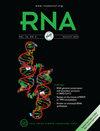SARS-CoV-2 三角洲变体茎环 2 节点 (s2m) 的核磁共振特征和配体结合位点
IF 4.2
3区 生物学
Q2 BIOCHEMISTRY & MOLECULAR BIOLOGY
引用次数: 0
摘要
SARS-CoV-2(SCoV-2)中的茎环 2(s2m)位于 3'-UTR 中。尽管有报道称 s2m 具有移动基因组元素的特征,可能会带来进化优势,但其功能一直不为人知。2020 年底,通过核磁共振测定了原始 SCoV-2 RNA 序列(武汉-胡-1)的二级结构,确定了碱基配对模式,并揭示了二级结构与 SARS-CoV-1 (SCoV-1) 的实质性差异。s2m 的上茎存在一个 G29742-A29756 错配,导致其不稳定,阻碍了完整的核磁共振分析。与原始序列相比,Delta 突变了一个变体,用 U29742 取代了 G29742。我们在此表明,这种突变导致在环境温度下结构更加明确,同时熔化温度升高。因此,我们能够利用选择性 RNA 标记和过滤二维 NOESY 以及四维 NMR 实验相结合的方法,鉴定出 90% 以上的相关 NMR 共振。我们基于异核 13C NOE 和 T1 测量以及核糖碳化学位移衍生的标准坐标,对 s2m Delta 的二级结构、(亚)纳秒动力学和核糖构象进行了全面的核磁共振分析。我们进一步证明,与武汉-胡-1 序列相比,Delta 中的 G29742U 突变对 s2m 的可药用性没有影响。有了这些结果,我们确定了 s2m 的柔性区域是小分子结合的主要位点。本文章由计算机程序翻译,如有差异,请以英文原文为准。
NMR characterization and ligand binding site of the stem loop 2 motif (s2m) from the Delta variant of SARS-CoV-2
The stem loop 2 motif (s2m) in SARS-CoV-2 (SCoV-2) is located in the 3’-UTR. Although s2m has been reported to display characteristics of a mobile genomic element that might lead to an evolutionary advantage, its function has remained unknown. The secondary structure of the original SCoV-2 RNA sequence (Wuhan-Hu-1) was determined by NMR in late 2020, delineating the base pairing pattern and revealing substantial differences in secondary structure compared to SARS-CoV-1 (SCoV-1). The existence of a single G29742-A29756 mismatch in the upper stem of s2m leads to its destabilization and impedes a complete NMR analysis. With Delta, a variant of concern has evolved with one mutation compared to the original sequence that replaces G29742 by U29742. We show here that this mutation results in a more defined structure at ambient temperature accompanied by a rise in melting temperature. Consequently, we were able to identify over 90 % of the relevant NMR resonances using a combination of selective RNA labeling and filtered 2D NOESY as well as 4D NMR experiments. We present a comprehensive NMR analysis of the secondary structure, (sub-) nanosecond dynamics and ribose conformation of s2m Delta based on heteronuclear 13C NOE and T1 measurements and ribose carbon chemical shift-derived canonical coordinates. We further show that the G29742U mutation in Delta has no influence on the druggability of s2m compared to the Wuhan-Hu-1 sequence. With the assignment at hand, we identify the flexible regions of s2m as primary site for small molecule binding.
求助全文
通过发布文献求助,成功后即可免费获取论文全文。
去求助
来源期刊

RNA
生物-生化与分子生物学
CiteScore
8.30
自引率
2.20%
发文量
101
审稿时长
2.6 months
期刊介绍:
RNA is a monthly journal which provides rapid publication of significant original research in all areas of RNA structure and function in eukaryotic, prokaryotic, and viral systems. It covers a broad range of subjects in RNA research, including: structural analysis by biochemical or biophysical means; mRNA structure, function and biogenesis; alternative processing: cis-acting elements and trans-acting factors; ribosome structure and function; translational control; RNA catalysis; tRNA structure, function, biogenesis and identity; RNA editing; rRNA structure, function and biogenesis; RNA transport and localization; regulatory RNAs; large and small RNP structure, function and biogenesis; viral RNA metabolism; RNA stability and turnover; in vitro evolution; and RNA chemistry.
 求助内容:
求助内容: 应助结果提醒方式:
应助结果提醒方式:


